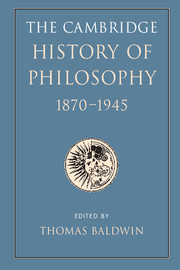Book contents
- Frontmatter
- Contents
- List of contributors
- Introduction
- I 1870–1914
- II 1914–1945
- 8 Logic and philosophy: the analytic programme
- 9 The diversity of philosophy
- 10 Knowledge, language, and the end of metaphysics
- 11 Philosophy and the exact sciences
- 46 First-order logic and its rivals
- 47 The golden age of mathematical logic
- 48 General relativity
- 49 Scientific explanation
- 50 The rise of probabilistic thinking
- 12 Mind and its place in nature
- 13 Philosophy and social science
- 14 Ethics, religion, and the arts
- 15 Law and politics
- Biobibliographical appendix
- Bibliography
- INDEX
- References
47 - The golden age of mathematical logic
from 11 - Philosophy and the exact sciences
Published online by Cambridge University Press: 28 March 2008
- Frontmatter
- Contents
- List of contributors
- Introduction
- I 1870–1914
- II 1914–1945
- 8 Logic and philosophy: the analytic programme
- 9 The diversity of philosophy
- 10 Knowledge, language, and the end of metaphysics
- 11 Philosophy and the exact sciences
- 46 First-order logic and its rivals
- 47 The golden age of mathematical logic
- 48 General relativity
- 49 Scientific explanation
- 50 The rise of probabilistic thinking
- 12 Mind and its place in nature
- 13 Philosophy and social science
- 14 Ethics, religion, and the arts
- 15 Law and politics
- Biobibliographical appendix
- Bibliography
- INDEX
- References
Summary
OVERVIEW
Modern symbolic logic, including axiomatic set theory, developed out of the works of Boole, Peirce, Cantor, and Frege in the nineteenth century. The contours of the subject as it is known today, however, were largely established in the decade between 1928 and 1938. During those years the scope of the discipline was expanded, both through clarification of the distinction between syntax and semantics and through recognition of different logical systems, in contrast to the conception of logic as a universal system within which all reasoning must be carried out. At the same time the primary focus of logical investigation was narrowed to the study of first-order logic (then called the ‘restricted functional calculus’), in which quantification is allowed only over the elements of an underlying structure, not over subsets thereof. The former development made possible the formulation and resolution of metasystematic questions, such as the consistency or completeness of axiomatic theories, while the latte, by isolating a more tractable logical framework, facilitated the derivation of theorems. Both developments led to the study of model-theoretic issues, such as the compactness of logical systems and the existence of non-isomorphic models of arithmetic and set theory.
In addition, questions concerning definability and decidability by axiomatic or algorithmic means were given precise mathematical formulations through the definition of the class of recursive functions and the enunciation of Church’s Thesis (that the recursive functions are exactly those intuitively characterised as being effectively computable). Formal proofs of indefinability and undecidability theorems thereby became possible, with profound implications for Hilbert’s proof theory and for the subsequent development of computer science.
- Type
- Chapter
- Information
- The Cambridge History of Philosophy 1870–1945 , pp. 592 - 599Publisher: Cambridge University PressPrint publication year: 2003



